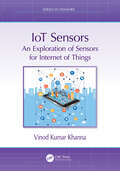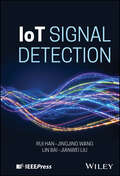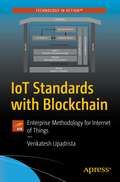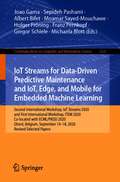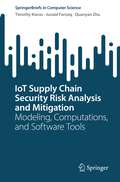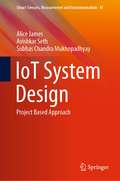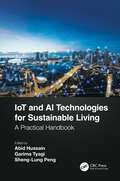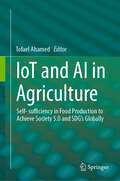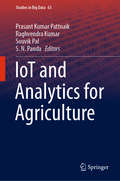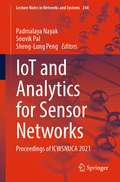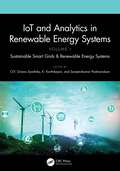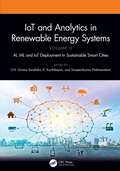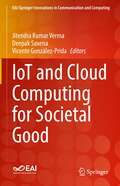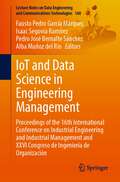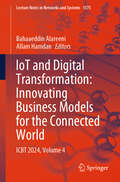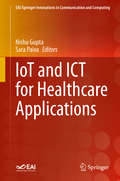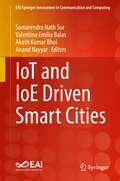- Table View
- List View
IoT Sensors: An Exploration of Sensors for Internet of Things (Series in Sensors)
by Vinod Kumar KhannaThis book introduces the basics of the Internet of Things (IoT) and explores the foundational role ofsensors in IoT applications. The IoT is a network of devices and objects: sensors, actuators, hardware,software, human beings, domestic appliances, health monitoring equipment, and other thingsconnected to the internet, which is designed to operate in a coordinated fashion to receive, process,and interpret signals and take appropriate action.It provides a seamless real-time interface between the physical and digital worlds by integratingsensors with networking, computation, and actuation facilities. This book sketches a perspective ofthe IoT with sensors as the focus of attention. Diverse applications of the IoT that are destined tomake an impact on our everyday lives in the near future are discussed.It presents a comprehensive overview of the most recent sensor technologies used in the IoT tokeep the reader abreast of the current advances at the frontiers of knowledge.The book will cater to student and professional audiences, and will be useful for postgraduate andPh.D. students studying physics, engineering, and computer science as well as researchers, engineers,and industrial workers engaged in this fast-progressing field.Key Features:• Explains the basic concepts and important terms of ‘Internet of Things’ in simple language• Provides an up-to-date coverage of the key sensors used in IoT applications• Explores IoT applications in smart cities, smart agriculture, smart factory, and many more
IoT Signal Detection
by Lin Bai Rui Han Jingjing Wang Jianwei LiuComprehensive reference covering signal detection for random access in IoT systems from the beginner to expert level With a carefully balanced blend of theoretical elements and applications, IoT Signal Detection is an easy-to-follow presentation on signal detection for IoT in terms of device activity detection, sparse signal detection, collided signal detection, round-trip delay estimation, and backscatter signal division, building progressively from basic concepts and important background material up to an advanced understanding of the subject. Various signal detection and estimation techniques are explained, e.g., variational inference algorithm and compressive sensing reconstruction algorithm, and a number of recent research outcomes are included to provide a review of the state of the art in the field. Written by four highly qualified academics, IoT Signal Detection discusses sample topics such as: ML, ZF, and MMSE detection, Markov chain Monte Carlo-based detection, variational inference-based detection, compressive sensing-based detection Sparse signal detection for multiple access, covering Bayesian compressive sensing algorithm and structured subspace pursuit algorithm Collided signal detection for multiple access using automatic modulation classification algorithm, round-trip delay estimation for collided signals Signal detection for backscatter signals, covering central limited theorem-based detection including detection algorithms, performance analysis, and simulation results Signal design for multi-cluster coordination, covering successive interference cancellation design, device grouping and power control, and constructive interference-aided multi-cluster coordination With seamless coverage of the subject presented in a linear and easy-to-understand way, IoT Signal Detection is an ideal reference for both graduate students and practicing engineers in wireless communications.
IoT Standards with Blockchain: Enterprise Methodology for Internet of Things
by Venkatesh UpadristaImplement a standardized end-to-end IoT implementation based on best practices and proven successes in IoT across multiple industries. With this book you'll discover the three business strategies for enterprises to adopt and remain relevant in the marketspace —the Customer Engagement strategy, the Business Transformation strategy, and the Business Productivity Improvement strategy. Pick the right strategy for your enterprise to ensure a clear mission and vision is established based on which IoT roadmap can be defined. Subsequently all business processes pertaining to the chosen business strategy are investigated to define use cases where IoT can be adopted to achieve that business strategy.Start by learning the generic industry perspective on digital transformation using IoT. Then move on to the IoT Standards Reference Model. It’s an abstract framework consisting of an interlinked set of clearly defined components for enterprises to successfully implement an IoT solution. The IoT Standards Reference Model can be applied for IoT use cases across any industry and is kept abstract in order to enable many, potentially different, IoT architectures to be implemented based on the model.With IoT thoroughly covered, you’ll dive into Blockchain and AI technology. This book will discuss the importance of using private blockchains for IoT use cases. You’ll also discover the five IoT-Blockchain implementation patterns that enterprises can enable for seamless communication between IoT devices, IoT Smart Gateways, and IoT platforms. These patterns help achieve trust, interoperability, and extendibility. Then you’ll work with AI and the IoT Standards Reference Model. The reference model recommends applying AI patterns to generate insights from data and take appropriate actions automatically. IoT Standards with Blockchain also provides perspective on how and when to apply AI in an IoT Context. In the end, you’ll have a solid methodology to execute large scale, enterprise-level IoT implementations. You’ll have an enterprise digital transformation framework for IoT that will enable your enterprise to operate better. What You'll LearnFacilitate IoT interoperability with best practicesImplement IoT platform securityFeed data and analytics to AI modelsWho This Book Is ForC-suite leaders and IT program managers across all industries, including manufacturing (Industry 4.0), logistics, oil and gas, transportation, energy, mining and metals, aviation, pharmaceuticals, medical devices, and hospitality.
IoT Streams for Data-Driven Predictive Maintenance and IoT, Edge, and Mobile for Embedded Machine Learning: Second International Workshop, IoT Streams 2020, and First International Workshop, ITEM 2020, Co-located with ECML/PKDD 2020, Ghent, Belgium, September 14-18, 2020, Revised Selected Papers (Communications in Computer and Information Science #1325)
by Albert Bifet Joao Gama Sepideh Pashami Moamar Sayed-Mouchawe Holger Fröning Franz Pernkopf Gregor Schiele Michaela BlottThis book constitutes selected papers from the Second International Workshop on IoT Streams for Data-Driven Predictive Maintenance, IoT Streams 2020, and First International Workshop on IoT, Edge, and Mobile for Embedded Machine Learning, ITEM 2020, co-located with ECML/PKDD 2020 and held in September 2020. Due to the COVID-19 pandemic the workshops were held online. The 21 full papers and 3 short papers presented in this volume were thoroughly reviewed and selected from 35 submissions and are organized according to the workshops and their topics: IoT Streams 2020: Stream Learning; Feature Learning; ITEM 2020: Unsupervised Machine Learning; Hardware; Methods; Quantization.
IoT Supply Chain Security Risk Analysis and Mitigation: Modeling, Computations, and Software Tools (SpringerBriefs in Computer Science)
by Quanyan Zhu Junaid Farooq Timothy KierasThis SpringerBrief introduces methodologies and tools for quantitative understanding and assessment of supply chain risk to critical infrastructure systems. It unites system reliability analysis, optimization theory, detection theory and mechanism design theory to study vendor involvement in overall system security. It also provides decision support for risk mitigation.This SpringerBrief introduces I-SCRAM, a software tool to assess the risk. It enables critical infrastructure operators to make risk-informed decisions relating to the supply chain, while deploying their IT/OT and IoT systems.The authors present examples and case studies on supply chain risk assessment/mitigation of modern connected infrastructure systems such as autonomous vehicles, industrial control systems, autonomous truck platooning and more. It also discusses how vendors of different system components are involved in the overall security posture of the system and how the risk can be mitigated through vendor selection and diversification. The specific topics in this book include: Risk modeling and analysis of IoT supply chains Methodologies for risk mitigation, policy management, accountability, and cyber insurance Tutorial on a software tool for supply chain risk management of IoT These topics are supported by up-to-date summaries of the authors’ recent research findings. The authors introduce a taxonomy of supply chain security and discusses the future challenges and directions in securing the supply chains of IoT systems. It also focuses on the need for joint policy and technical solutions to counter the emerging risks, where technology should inform policy and policy should regulate technology development.This SpringerBrief has self-contained chapters, facilitating the readers to peruse individual topics of interest. It provides a broad understanding of the emerging field of cyber supply chain security in the context of IoT systems to academics, industry professionals and government officials.
IoT System Design: Project Based Approach (Smart Sensors, Measurement and Instrumentation #41)
by Subhas Chandra Mukhopadhyay Alice James Avishkar SethThis book presents a step by step design approach to develop and implement an IoT system starting from sensor, interfacing to embedded processor, wireless communication, uploading measured data to cloud including data visualization along with machine learnings and artificial intelligence. The book will be extremely useful towards a hands-on approach of designing and fabricating an IoT system especially for upper undergraduate, master and PhD students, researchers, engineers and practitioners.
IoT System Testing: An IoT Journey from Devices to Analytics and the Edge
by Jon Duncan HagarTo succeed, teams must assure the quality of IoT systems. The world of technology continually moves from one hot area to another; this book considers the next explosion—of IoT—from a quality testing viewpoint. You'll first gain an introduction to the Internet of Things (IoT), V&V, and testing. Next, you'll be walked through IoT test planning and strategy over the full life cycle, including the impact of data analytics and AI. You will then delve deeper into IoT security testing and various test techniques, patterns, and more. This is followed by a detailed study of IoT software test labs, architecture, environments and AI. There are many options for testing IoT qualities based on the criticality of the software and risks involved; each option has positives, negatives, as well as cost and schedule impacts. The book will guide start-up and experienced teams into these paths and help you to improve the testing and quality assessment of IoT systems. What You Will LearnUnderstand IoT software test architecture and planningMaster IoT security testing and test techniquesStudy IoT test lab automation and architecturesReview the need for IoT security, data analytics, AI, Neural Networks and dependability using testing and V&V Who This Book Is ForReaders with basic knowledge of software development who want to learn more about IoT testing and its intricacies, as well as companies moving into the domain of IoT, and even those already deep into the IoT domain will benefit from this book.
IoT and AI Technologies for Sustainable Living: A Practical Handbook
by Abid HussainThis book brings together all the latest methodologies, tools and techniques related to the Internet of Things and Artificial Intelligence in a single volume to build insight into their use in sustainable living. The areas of application include agriculture, smart farming, healthcare, bioinformatics, self-diagnosis systems, body sensor networks, multimedia mining, and multimedia in forensics and security. This book provides a comprehensive discussion of modeling and implementation in water resource optimization, recognizing pest patterns, traffic scheduling, web mining, cyber security and cyber forensics. It will help develop an understanding of the need for AI and IoT to have a sustainable era of human living. The tools covered include genetic algorithms, cloud computing, water resource management, web mining, machine learning, block chaining, learning algorithms, sentimental analysis and Natural Language Processing (NLP). IoT and AI Technologies for Sustainable Living: A Practical Handbook will be a valuable source of knowledge for researchers, engineers, practitioners, and graduate and doctoral students working in the field of cloud computing. It will also be useful for faculty members of graduate schools and universities.
IoT and AI in Agriculture: Self- sufficiency in Food Production to Achieve Society 5.0 and SDG's Globally
by Tofael AhamedThis book reviews recent innovations in the smart agriculture space that use the Internet of Things (IoT) and sensing to deliver Artificial Intelligence (AI) solutionsto agricultural productivity in the agricultural production hubs. In this regard, South and Southeast Asia are one of the major agricultural hubs of the world, facing challenges of climate change and feeding the fast-growing population. To address such challenges, a transboundary approach along with AI and BIG data for bioinformatics are required to increase yield and minimize pre- and post-harvest losses in intangible climates to drive the sustainable development goal (SDG) for feeding a major part of the 9 billion population by 2050 (Society 5.0 SDG 1 & 2). Therefore, this book focuses on the solution through smart IoT and AI-based agriculture including pest infestation and minimizing agricultural inputs for in-house and fields production such as light, water, fertilizer and pesticides to ensure food security aligns with environmental sustainability. It provides a sound understanding for creating new knowledge in line with comprehensive research and education orientation on how the deployment of tiny sensors, AI/Machine Learning (ML), controlled UAVs, and IoT setups for sensing, tracking, collection, processing, and storing information over cloud platforms for nurturing and driving the pace of smart agriculture in this current time. The book will appeal to several audiences and the contents are designed for researchers, graduates, and undergraduate students working in any area of machine learning, deep learning in agricultural engineering, smart agriculture, and environmental science disciplines. Utmost care has been taken to present a varied range of resource areas along with immense insights into the impact and scope of IoT, AI and ML in the growth of intelligent digital farming and smart agriculture which will give comprehensive information to the targeted readers.
IoT and AI in Agriculture: Smart Automation Systems for increasing Agricultural Productivity to Achieve SDGs and Society 5.0
by Tofael AhamedThis book covers smart agricultural space and its further development with an emphasis on ultra-saving labor shortages using AI-based technologies. A transboundary approach, as well as artificial intelligence (AI) and big data for bioinformatics, are required to increase timeliness and supplement the labor shortages, ensure the safety of intangible labor migration system to achieve one of the sustainable development goals (SDG) to secure food security (Society 5.0, SDG 1 and 2). With this in mind, the book focuses on the solution through smart Internet of Things (IoT) and AI-based agriculture, such as automation navigation, insect infestation, and decreasing agricultural inputs such as water and fertilizer, to maintain food security while ensuring environmental sustainability. Readers will gain a solid foundation for developing new knowledge through the in-depth research and education orientation of the book on how the deployment of outdoor and indoor sensors, AI/machine learning (ML), and IoT setups for sensing, tracking, collection, processing, and storing information over cloud platforms is nurturing and driving the pace of smart agriculture outdoor and indoors at this current time. Furthermore, the book introduces the smart system for automation challenges that are important for an unmanned system for considering safety and security points. The book is designed for researchers, graduates, and undergraduate students working in any area of machine learning, deep learning in agricultural engineering, smart agriculture, and environmental science. The greatest care has been made to deliver a diverse range of resource areas, as well as enormous insights into the significance and scope of IoT, AI, and ML in the development of intelligent digital farming and smart agriculture, providing comprehensive information to the intended readers.
IoT and AI-Enabled Healthcare Solutions and Intelligent Disease Prediction
by Bhoopesh Singh Bhati Dimple Tiwari Nitesh Singh BhatiThe book presents fundamental to advanced concepts of AI and IoT in healthcare and disease prediction, demonstrating the emerging mechanisms, including machine learning, deep learning, image sensing, and explainable AI models to handle issues in healthcare industries with real-life scenarios. Included chapters are contributed by experienced professionals and academicians who examine severe diseases, applications, models, tools, frameworks, case studies, applications, and best practices in Healthcare. This book integrates the medical domain with AI technology. It covers trending explainable AI, computer vision (CV), and IoT that facilitate automation for healthcare solutions and medical diagnostics. The primary focus on explainable AI uncovers the black box of deep learning and bridges the distance between medical professionals and technologists. IoT in Healthcare: provides a mechanism of image sensing and is helpful in surgical tools.
IoT and Advanced Intelligence Computation for Smart Agriculture
by Mourade Azrour Jamal Mabrouki Sultan AhmadSmart agriculture is an approach to maintaining nature without compromising the basic needs of future generations while at the same time improving the efficiency of farming. The main achievements of smart agriculture in terms of sustainable agriculture are crop rotation, controlling nutrient deficiencies in crops, pest and disease control, recycling, and water harvesting, leading to a safer environment overall. Living organisms depend on the nature of biodiversity and are exposed to pollution due to waste emissions, use of fertilizers and pesticides, degraded dead plants, and so on. The emission of greenhouse gases affects plants, animals, humans, and the environment; hence, this necessitates a better environment for living organisms.The purpose of this book is to provide a comprehensive overview of the latest advancements, challenges, and potential applications of artificial intelligence (AI) technology and the Internet of Things (IoT) in the future of intelligent agriculture. The book is primarily focused on equipping younger researchers, graduates, and professionals in the industry with the necessary knowledge to understand the advantages of AI technology, machine learning, and data analytics methods in improving current agricultural practices.Key features include the following: The book showcases the latest advancements in AI and smart agriculture technologies The text emphasizes sustainable practices supported by AI, highlighting how technology can enhance productivity while minimizing environmental impact Readers will learn how to harness big data and analytics to drive informed decision-making and optimize their agricultural yields
IoT and Analytics for Agriculture (Studies in Big Data #63)
by Prasant Kumar Pattnaik Raghvendra Kumar Souvik Pal S. N. PandaThis book presents recent findings on virtually every aspect of wireless IoT and analytics for agriculture. It discusses IoT-based monitoring systems for analyzing the crop environment, and methods for improving the efficiency of decision-making based on the analysis of harvest statistics. In turn, it addresses the latest innovations, trends, and concerns, as well as practical challenges encountered and solutions adopted in the fields of IoT and analytics for agriculture. In closing, it explores a range of applications, including: intelligent field monitoring, intelligent data processing and sensor technologies, predictive analysis systems, crop monitoring, and weather data-enabled analysis in IoT agro-systems.
IoT and Analytics for Sensor Networks: Proceedings of ICWSNUCA 2021 (Lecture Notes in Networks and Systems #244)
by Sheng-Lung Peng Souvik Pal Padmalaya NayakThis book includes high-quality research papers presented at the 1st International Conference on Wireless Sensor Networks, Ubiquitous Computing and Applications (ICWSNUCA, 2021), which is held at Gokaraju Rangaraju Institute of Engineering and Technology, Hyderabad, India, during 26–27 February, 2021. This volume focuses on the applications, use-cases, architectures, deployments, and recent advances of wireless sensor networks as well as ubiquious computing. Different research topics are illustrated in this book, like wireless sensor networks for the Internet of Things; IoT applications for eHealth; smart cities; architectures for WSNs and IoT, WSNs hardware and new devices; low-power wireless technologies; wireless ad hoc sensor networks; routing and data transfer in WSNs; multicast communication in WSNs; security management in WSNs and in IoT systems; and power consumption optimization in WSNs.
IoT and Analytics in Renewable Energy Systems (Volume 1): Sustainable Smart Grids & Renewable Energy Systems
by O. V. Gnana SwathikaSmart grid technologies include sensing and measurement technologies, advanced components aided with communications and control methods along with improved interfaces and decision support systems. Smart grid techniques support the extensive inclusion of clean renewable generation in power systems. Smart grid use also promotes energy saving in power systems. Cyber security objectives for the smart grid are availability, integrity and confidentiality. Five salient features of this book are as follows: AI and IoT in improving resilience of smart energy infrastructure IoT, smart grids and renewable energy: an economic approach AI and ML towards sustainable solar energy Electrical vehicles and smart grid Intelligent condition monitoring for solar and wind energy systems
IoT and Analytics in Renewable Energy Systems (Volume 2): AI, ML and IoT Deployment in Sustainable Smart Cities
by Sanjeevikumar Padmanaban K. Karthikeyan O. V. Gnana SwathikaSmart cities emanate from a smart renewable-energy-aided power grid. The smart grid technologies offer an array of benefits like reliability, availability, and resiliency. Smart grids phenomenally contribute to facilitating cities reaching those sustainability goals over time. Digital technologies, such as the Internet of Things (IoT), automation, artificial intelligence (AI) and machine learning (ML) significantly contribute to the two-way communication between utilities and customers in smart cities. Five salient features of this book are as follows: Smart grid to the smart customer Intelligent computing for smart grid applications Novel designs of IoT systems such as smart healthcare, smart transportation, smart home, smart agriculture, smart manufacturing, smart grid, smart education, smart government, smart traffic management systems Innovations in using IoT and AI in improving resilience of smart energy infrastructure Challenges and future research directions of smart city applications
IoT and Cloud Computing for Societal Good (EAI/Springer Innovations in Communication and Computing)
by Jitendra Kumar Verma Deepak Saxena Vicente González–Prida DíazThis book gathers the state-of-the-art for industrial application of scientific and practical research in the Cloud and IoT paradigms to benefit society. The book first aims to discuss and outline various aspects of tackling climate change. The authors then discuss how Cloud and IoT can help for digital health and learning from industrial aspects. The next part of book discusses technical improvements in the fields of security and privacy. The book also covers Smart Homes and IoT in agriculture. The book is targeted towards advancing undergraduate, graduate, and post graduate students, researchers, academicians, policymakers, various government officials, NGOs, and industry research professionals who are currently working in the field of science and technology either directly or indirectly to benefit common masses.
IoT and Data Science in Engineering Management: Proceedings of the 16th International Conference on Industrial Engineering and Industrial Management and XXVI Congreso de Ingeniería de Organización (Lecture Notes on Data Engineering and Communications Technologies #160)
by Fausto Pedro García Márquez Isaac Segovia Ramírez Pedro José Bernalte Sánchez Alba Muñoz del RíoThis book presents the selected research works from the 16th International Conference on Industrial Engineering and Industrial Management in 2022. The conference was promoted by ADINGOR (Asociación para el Desarrollo de la Ingeniería de Organización), organized by Ingenium Research Group at Universidad de Castilla-La Mancha, Spain, and it took place on July 7th and 8th, 2022, in Toledo, Spain. The book highlights some of the latest research advances and cutting-edge analyses of real-world case studies on Industrial Engineering and Industrial Management from a wide range of international contexts. It also identifies business applications and the latest findings and innovations in Operations Management and in Decision Sciences.
IoT and Digital Transformation: ICBT 2024, Volume 4 (Lecture Notes in Networks and Systems #1575)
by Allam Hamdan Bahaaeddin AlareeniThis book examines how smart devices, sensors, and interconnected data ecosystems are redefining business operations, enhancing customer experiences, and shaping new competitive strategies. In today&’s hyperconnected world, the Internet of Things (IoT) is more than a technology trend, it is a transformative force driving digital innovation across industries. Offering a comprehensive exploration of IoT&’s role in business transformation, this book illustrates how traditional models are evolving into agile, data-driven systems. Through diverse research methodologies and real-world case studies, it addresses the key opportunities and challenges presented by connected environments. It serves as a practical guide for business leaders, innovators, and policymakers aiming to harness IoT&’s full potential for operational excellence and sustainable growth. What You&’ll Discover: · How IoT is enabling new forms of business model innovation · Strategies for integrating IoT into digital transformation initiatives · Policy and managerial insights for connected industries <span lang="DE" style="font-family: Symbol; mso-fareast-font-family: Symbol; mso-bid
IoT and ICT for Healthcare Applications (EAI/Springer Innovations in Communication and Computing)
by Nishu Gupta Sara PaivaThis book provides an insight on the importance that Internet of Things (IoT) and Information and Communication Technology (ICT) solutions can have in taking care of people's health. Key features of this book present the recent and emerging developments in various specializations in curing health problems and finding their solutions by incorporating IoT and ICT. This book presents useful IoT and ICT applications and architectures that cater to their improved healthcare requirements. Topics include in-home healthcare services based on the Internet-of-Things; RFID technology for IoT based personal healthcare; Real-time reporting and monitoring; Interfacing devices to IoT; Smart medical services; Embedded gateway configuration (EGC); Health monitoring infrastructure; and more.Features a number of practical solutions and applications of IoT and ICT on healthcare;Includes application domains such as communication technology and electronic materials and devices;Applies to researchers, academics, students, and practitioners around the world.
IoT and IoE Driven Smart Cities (EAI/Springer Innovations in Communication and Computing)
by Valentina Emilia Balas Akash Kumar Bhoi Anand Nayyar Samarendra Nath SurThis book provides detail on applying Internet of Things (IoT) and Internet of Everything (IoE) in smart cities and their design aspects related to physical and network layer models. The authors explore the possibilities of utilizing communication technologies like multi-input multi-output (MIMO), narrow-band IoT (NB-IoT), ultra-reliable low latency communications (URLLC), enhanced mobile broadband (eMBB), and massive machine-type communications (mMTC) for successful implementation of the IoT/IoE. The authors also address the development and advancement in cloud computing to support IoT and IoE. Research on the challenges and future predictions for efficiently implementing and exploring the benefits of smart cities are also explored. The book pertains to researchers, academics, and professionals in the field.Discusses the applicability of Internet of Things (IoT) and Internet of Everything (IoE) for smart cities;Addresses different protocols, networks, and technologies related to the implementation of IoT and IoE for smart cities;Provides a detailed overview on the physical and network layer design and signal processing algorithms related to IoT and IoE.
IoT and Low-Power Wireless: Circuits, Architectures, and Techniques (Devices, Circuits, and Systems)
by Christopher SiuThe book offers unique insight into the modern world of wireless communication that included 5G generation, implementation in Internet of Things (IoT), and emerging biomedical applications. To meet different design requirements, gaining perspective on systems is important. Written by international experts in industry and academia, the intended audience is practicing engineers with some electronics background. It presents the latest research and practices in wireless communication, as industry prepares for the next evolution towards a trillion interconnected devices. The text further explains how modern RF wireless systems may handle such a large number of wireless devices. <li>Covers modern wireless technologies (5G, IoT), and emerging biomedical applications <li>Discusses novel RF systems, CMOS low power circuit implementation, antennae arrays, circuits for medical imaging, and many other emerging technologies in wireless co-space. <li>Written by a mixture of top industrial experts and key academic professors.
IoT and ML for Information Management: A Smart Healthcare Perspective (Studies in Computational Intelligence #1169)
by Suyel NamasudraThis book discusses the roles of the Internet of Things (IoT) and machine learning (ML) in smart health care, including the integration of cloud computing with IoT and ML for managing healthcare data. It presents the fundamentals and many applications of IoT and ML in different areas of smart health care. It deliberates upon security and privacy issues, including trust concerns about smart healthcare systems based on IoT and ML algorithms. This book is concluded by discussing challenges and future work directions in smart health care using IoT and ML, and it serves as a reference resource for researchers and practitioners in academia and industry.
IoT and Smart Devices for Sustainable Environment (EAI/Springer Innovations in Communication and Computing)
by Mourade Azrour Azeem Irshad Rajasekhar ChagantiThis book presents research related to smart devices and Internet of Things (IoT) that are intended to advance environmental sustainability. With sustainability as the focus, the topics covered include designing and controlling of smart systems, networking and machine learning, monitoring and controlling the environment, smart metering, authentication and authorization, and software and systems solution. The authors discuss how IoT can aid in sustainability through its implementation of systems interconnecting several objects, whether in the physical or in the virtual worlds. The chapters also present several applications including in smart homes, transportation, and healthcare. The book pertains to researchers, academics, and professionals.
IoT and WSN based Smart Cities: A Machine Learning Perspective (EAI/Springer Innovations in Communication and Computing)
by Shalli Rani R. Maheswar Vyasa SaiThis book provides an investigative approach to how machine learning is helping to maintain and secure smart cities, including principal uses such as smart monitoring, privacy, reliability, and public protection. The authors cover important areas and issues around implementation roadblocks, ideas, and opportunities in smart city development. The authors also include new algorithms, architectures and platforms that can accelerate the growth of smart city concepts and applications. Moreover, this book provides details on specific applications and case studies related to smart city infrastructures, big data management, and prediction techniques using machine learning.
